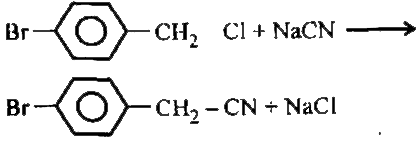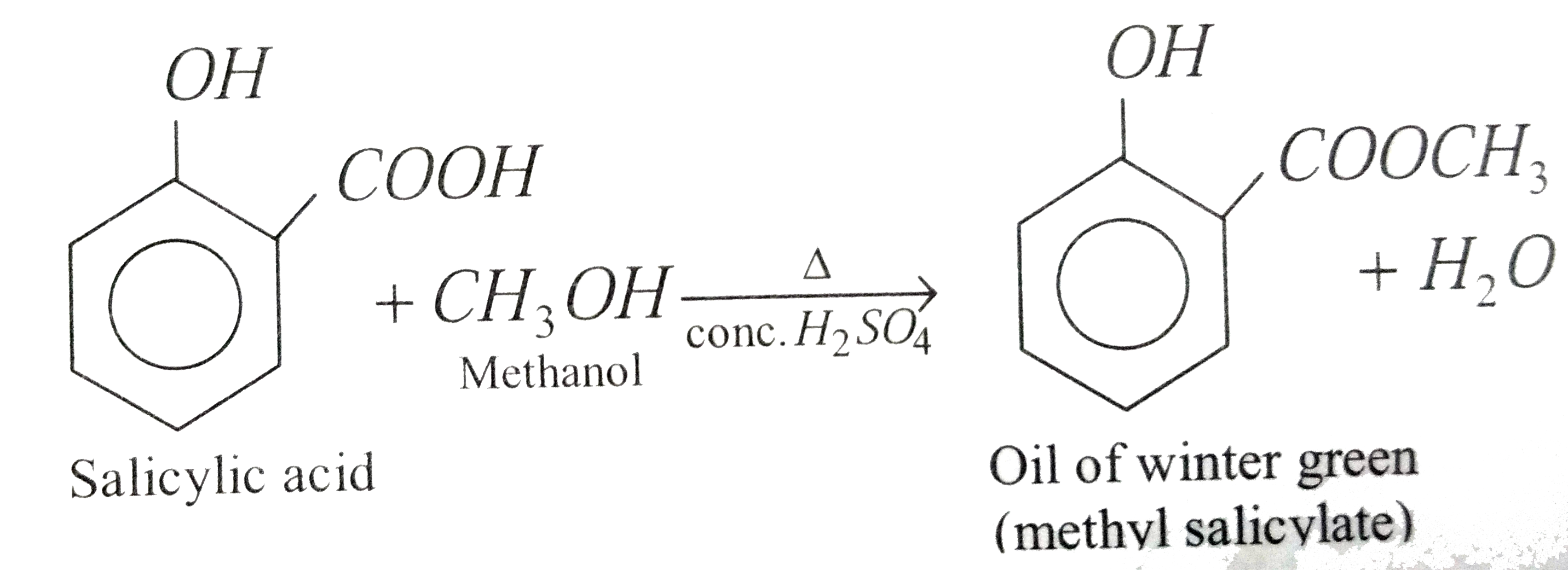Explore topic-wise InterviewSolutions in .
This section includes InterviewSolutions, each offering curated multiple-choice questions to sharpen your knowledge and support exam preparation. Choose a topic below to get started.
| 24151. |
The reaction of 4 -bromobenzyl chloride with NaCl in ethanol forms |
|
Answer» 4-Bromobenzyl CYANIDE  Nucleophilic SUBSTITUTION of the alkylic halide with `CN^-` group take PLACE. |
|
| 24152. |
The reaction obey 1 order with respect to H_(2) and Icl both H_(2(g))+2ICl_((g)) to 2HCl_((g))+I_(2(g)) Which of the following mechanism is consistent with the given fact ? Mechanism A : H_(2(g))+2ICl to 2HCl_((g))+I_(2(g)) Mechanism B : (i) H_(2(g))+ICl_((g)) overset ("slow") underset (HCl_((g))+HI_((g)))( to ) (ii) HI_((g))+ICl_((g)) to HCl_((g))+I_(2) |
| Answer» Answer :D | |
| 24153. |
The reaction occuring at the anode during the working of alkaline dry cell - |
|
Answer» `Zn + H_(2)O to ZNO + 2 OH^(-) + 2e^(-)` `Zn + 2 OH^(-) to ZnO+ H_(2)O + 2 e^(-)` |
|
| 24154. |
The reaction NO_(2(g))+O_((g)) to CO_(2(g)) +NO_((g)) proceeds in the following two steps at 500 K NO_(2(g)) + NO_2to NO+NO_3 Step - 1(slow) NO_3 + CO to CO_2 + NO_2 Step -2 (fast) Which of the following rate expressions is correct for the above reaction ? |
|
Answer» Rate `=-(d(NO_2])/(dt)=K[NO_2]` Rate = `(dx)/(dt) = k [NO_(2)]^(2)` |
|
| 24155. |
The reaction not involved in the concentration of bauxite are by Hall's process is |
|
Answer» `Al_(2)O_(3)+ Na_(2)CO_(3) to 2NaAlO_(3)+CO_(2)` |
|
| 24156. |
The Product not involved in the concentration of bauxite are by Hall's process is |
|
Answer» Al |
|
| 24157. |
The reaction NO_(2)Cl(g) +NO(g) ltimplies NO_(2)(g) + NOCl(g) is a single step reversible reaction. The energy of activation for the forward reaction is 28.9 kJ and that for the backward reaction is 41.8 kJ. Draw energy level diagram for the reaction. Indicate E_(a)f and E_(a)b and DeltaH in the diagram. |
| Answer» SOLUTION :As the energy of activation for the FORWARD reaction is LESS than the value for the backward reaction, this MEANS that the forward reaction is exothermic while the backward reaction is ENDOTHERMIC in nature. The various energy changes have been shown in the figure. | |
| 24158. |
The reaction : N_(2)O_(5)( "in" (C)Cl_(4) "solution") to2NO_(2)("same solution") +1//2O_(2)(g) is of first order in N_(2)O_(5) with rate constant = 6.2 xx 10^(-4)s^(-1). What is the value of the rate of reaction when [N_(2)O_(5)] with rate constant = 6.2 xx 10^(-4)s^(-1). What is the rate of reaction when N_(2)O_(5)=12.5 mol L^(-1)? |
|
Answer» `5.15 xx 10^(-5) MOL L^(-1)s^(-1)` `(6.2 xx 10^(-4) s^(-1)) xx (1.25 mol L^(1))` `7.75 xx 10^(-4) mol L^(-1)s^(-1)` |
|
| 24159. |
The reaction N_(2)O_(5) (in C Cl_(4) solution ) to 2 NO_(2) (solution) + (1)/(2) O_(2) (gas ) is of first order in N_(2)O_(5) with rate constant 6.2 xx 10^(-1) s^(-1) . What is the value of rate of reaction when [N_(2)O_(5)] = 1.25 "mole" l^(-1) |
|
Answer» `7.75 xx 10^(-1) "MOLE" l^(-1) s^(-1)` = `7.75 xx 10^(-1)` mol `l^(-1) s^(-1)`. |
|
| 24160. |
The reaction ,N_2O_5 in 2NO_2 + (1//2)O_2(g) is of first order for N_2O_5 with rate constant 6.2 xx 10^(-4)s^(-1). What is the value of rate of reaction when [N_2O_5]= 1.25 mol L^(-1) ? |
|
Answer» `5.15 XX 10^(-5) MOL L^(-1) s^(-1)` |
|
| 24161. |
The reaction N_(2(g))+O_(2(g))rarr2NO_((g)) is endothermic. The forward reaction is |
|
Answer» FAVOURED by DECREASE in temperature |
|
| 24162. |
The reaction N_(2)(g)+3H_(2)(g)hArr2NH_(3)(g) is in equlibrium. Now the reaction mixture is compressed to half the volume |
|
Answer» More of ammonia will be formed |
|
| 24164. |
The reaction, MnO_(4)^(2-) +e^(-)hArr MnO_(4)^(-) is shifted to right in |
|
Answer» an ACIDIC MEDIUM |
|
| 24165. |
The reaction MnO_(4)^(-) + e^(-) to MnO_(4)^(2-) occur in |
|
Answer» a BASIC MEDIUM |
|
| 24166. |
The reaction MnO_4^(-) + e^(-) rarr MnO_4^(2-) takes place in : |
|
Answer» BASIC medium |
|
| 24167. |
The reaction M^(2)+2e^(-) to M has standard potential of -0.66V . This means |
|
Answer» M cannot REPLACE hydrogen from acid |
|
| 24168. |
The reaction ltBrgt CH_(3)-underset(CH_(3))underset(|)overset(CH_(3))overset(|)(C)-ON a+CH_(3)CH_(2)Cloverset(-NaCl)toCH_(3)-underset(CH_(3))underset(|)overset(CH_(3))overset(|)(C)-O-CH_(2)-CH_(3) is called. |
|
Answer» Etard reaction |
|
| 24169. |
C_4 cycle takes place in: |
|
Answer» BASIC medium |
|
| 24170. |
The reaction L to M is started with 10.0 of L. After 30 and 90 minutes 5.0 g and 1.25 g of L respecetively are left. The order of the reaction is |
|
Answer» 0 |
|
| 24171. |
The reaction ,RCOOAg + Br_2 overset(C Cl_4)rarr RBr + AgBr+CO_2 is called : |
|
Answer» HVZ REACTION |
|
| 24172. |
The reaction L rarr M is started with 10 g of L. After 30 and 90 minute, 5 g and 1.25g of L are left respectively. The order of reaction.is: |
|
Answer» 0 |
|
| 24173. |
The reaction kinetics can be studied by |
|
Answer» Measurement of `PH` |
|
| 24174. |
The reaction ,KI +I_(2-)>KI_3 shows: |
| Answer» Answer :D | |
| 24175. |
The reaction is of 1^(st) order.At initial the concentration of reactant is 0.1 mol L^(1) .Rate constant is =3xx10^(-2)s^(-1).Then what is the rate of reaction at initial? |
|
Answer» `3xx10^(-3)` MOL `L^(-1)s^(-1)` `=(3xx10^(-2)L^(1)s^(-1))`(0.1 mol `L^(-1)`) `=3xx10^(-3) "mol" L^(-1) s^(-1)` |
|
| 24176. |
The reaction is obtained by the action of alcholic KCN and what? |
|
Answer» 1-butyl ehtyl ether `CH_(3)- UNDERSET(CH_(3)) underset(|)overset(CH_(3)) overset(|)C-Cl+ underset("alc")(C_()H_(5)ONa)+ CH_(3)- overset(CH_(2)) overset(||)C-CH_(3)+C_(2)H_(5)OH+NaCl` |
|
| 24177. |
The reaction is known as |
|
Answer» pinacol-pinacolone rearrangement |
|
| 24178. |
The reaction :is known as ….. |
|
Answer» Sandmeyer's REACTION |
|
| 24179. |
The reactionis fastest when X is: |
|
Answer» CL |
|
| 24180. |
The reaction is carried out in the presence of pyridne, Which of the followingmechanisms does it follow? |
| Answer» SOLUTION :NA | |
| 24181. |
The reaction involving the treatment of benzene diazonium chloride with copper powder and HCl is treated as: |
|
Answer» SANDMEYER's REACTION |
|
| 24182. |
The reaction involved in the oil of Winter Green test is salicylic acid underset(conc." "H_(2)SO_(4))overset(Delta)to product. The product is treated with Na_(2)CO_(3) solution. The missing reagent in the above reaction is |
|
Answer» NaOH  . .
|
|
| 24183. |
The reaction involving condensation of acetic anhydride with a n aromatic aldehyde by a carboxylate ion is an exaple of : |
|
Answer» ALDOL condensation |
|
| 24184. |
The reaction involved in the oil of Winter Green test is: salicylic acid underset (Conc. H_(2)SO_(4))overset(X,Delta)(to) Product. The product is treated with Na_(2)CO_(3) solution. The missing reagent X in the above reaction is |
|
Answer» NaOH 
|
|
| 24185. |
The reaction involved in the oil of winter Green test is salicyclic acid underset("conc." H_(2)SO_(4))overset('X',Delta)(rarr)product. The product is treated with Na_(2)CO_(3) solution. The missing reagent 'X' in the above reaction is : |
|
Answer» NaOH |
|
| 24186. |
The reaction intermediate formed in the given reaction bears (AAK_MCP_35_NEET_CHE_E35_021_Q01) |
|
Answer» POSITIVE charge |
|
| 24187. |
The reaction intermediate carbenes are produced from" |
| Answer» Answer :D | |
| 24188. |
The reaction in which the yield of the products can not be increased by the application of high pressure is – |
|
Answer» `PCl_(3) (g) + Cl_(2) (g)hArrPCl_(5) (g)` |
|
| 24189. |
The reaction in which the samesubstance undergoes oxidationas well as reduction is called "…..................." reaction. |
|
Answer» |
|
| 24190. |
The reaction in which the same substance undergoes both oxidation and reduction is known as __________ reaction. |
| Answer» SOLUTION :DISPROPORTIONATION | |
| 24191. |
The reaction in which phenol differs from alcohol is |
|
Answer» it UNDERGOES esterification with carboxylic acid |
|
| 24192. |
The reaction in which hydrogen is not one of the product is |
|
Answer»
|
|
| 24193. |
The reaction in which heat is absorbed is known as: |
|
Answer» EXOTHERMIC |
|
| 24194. |
The reaction in which DeltaHgtDeltaU is |
|
Answer» `N_(2(g)) + O_(2(g)) to 2NO_(g)` For the reaction, `CaCO_(3(s)) to CaO_(s)+CO_(2(g))` `Deltan_(g)=1` `:. DeltaH gt DeltaU` |
|
| 24195. |
The reaction in the Kipp.s apparatus stops on closing the outlet, because: |
|
Answer» The acid becomes weak |
|
| 24196. |
The reaction in which catalyst and reactant have one phase are known as: |
|
Answer» GASEOUS reaction |
|
| 24197. |
The reaction , illustrate : |
|
Answer» Gabriel.s phthalimide reaction |
|
| 24198. |
The reaction H_(2)S+H_(2)O_(2)rarrS+2H_(2)Oshows |
|
Answer» acidic nature of `H_(2)O_(2)` |
|
| 24199. |
The reaction ,H2 S+H2 O2 →S+2H2 O shows : |
|
Answer» `ACIDIC nature ofH_2O_2` |
|
| 24200. |
The reaction, H_2S+H_2O_2 rarrS+2H_2O manifests: |
|
Answer» ACIDIC NATURE of `H_2O_2` |
|